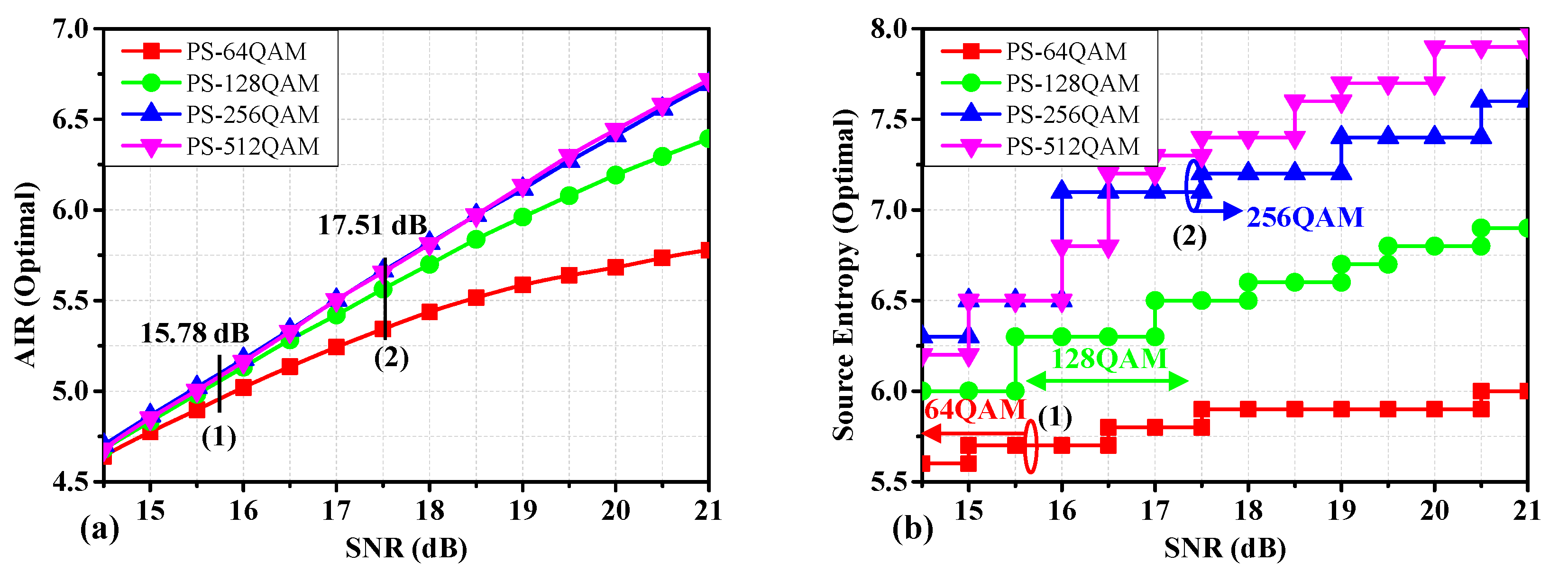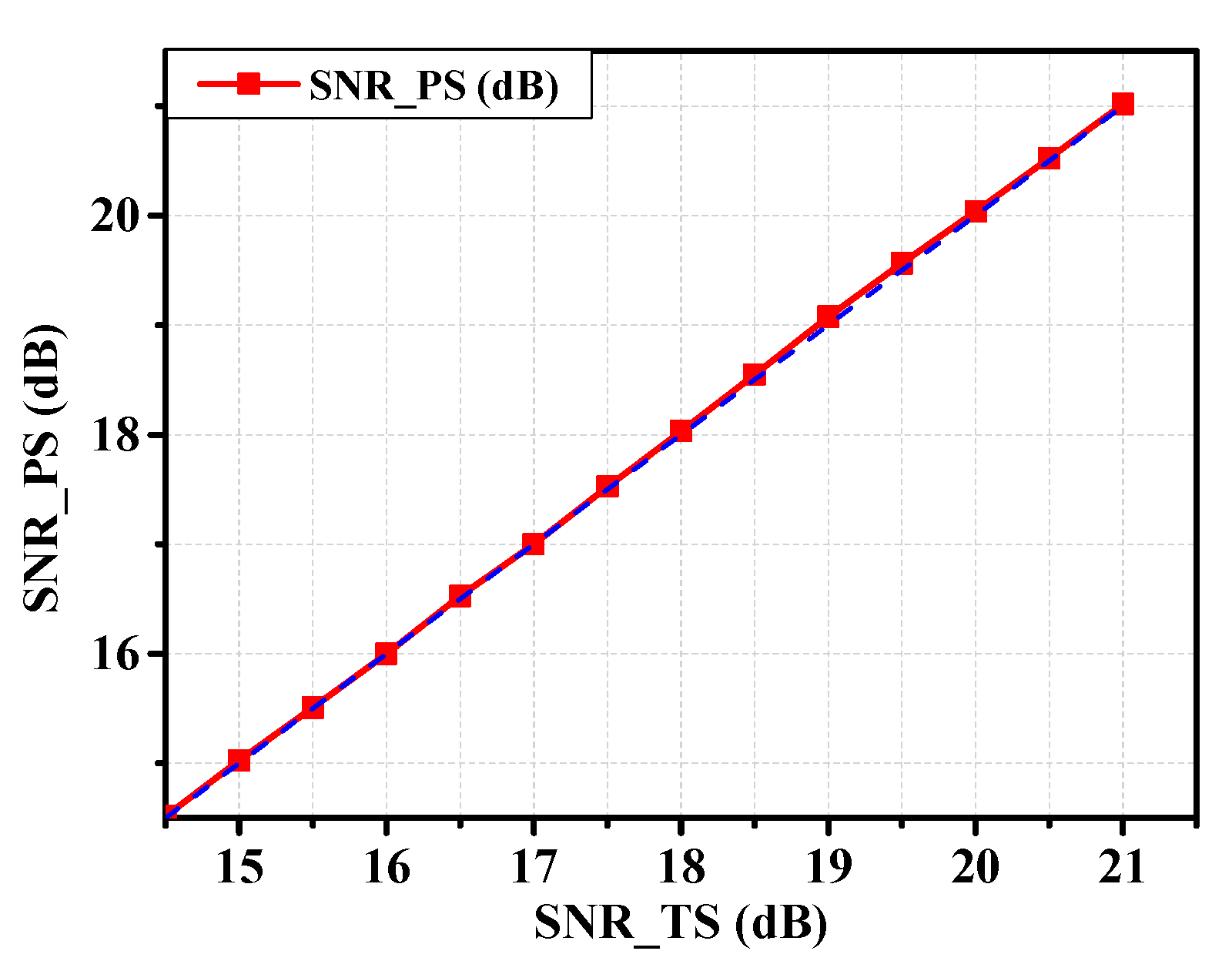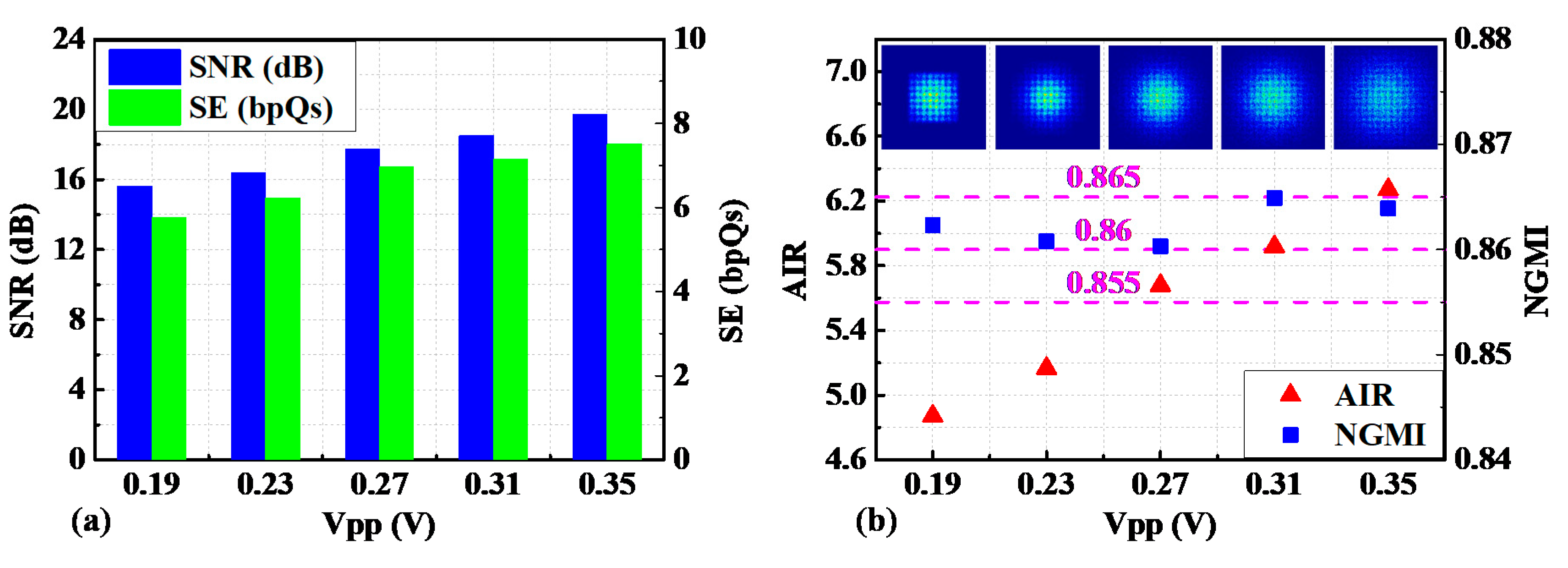On the Achievable Information Rate of Probabilistic Shaping QAM Order and Source Entropy in Visible Light Communication Systems
Abstract
:1. Introduction
2. Principles of Probabilistic Shaping
3. Experimental and Simulation Setup
4. Results and Discussion
4.1. Simulation Results
- (1)
- The NGMI threshold is 0.92, which corresponds to the FEC code rate 9/10;
- (2)
- The NGMI threshold is 0.86, which corresponds to the FEC code rate 5/6;
- (3)
- The code rate .
4.2. Experimental Results
5. Conclusions
Author Contributions
Funding
Conflicts of Interest
References
- Jovicic, A.; Li, J.; Richardson, T. Visible light communication: Opportunities, challenges and the path to market. IEEE Commun. Mag. 2015, 51, 26–32. [Google Scholar] [CrossRef]
- Chi, N.; Haas, H.; Kavehrad, M.; Little, T.; Huang, X. Visible light communications: Demand factors, benefits and opportunities. IEEE Wirel. Commun. 2015, 22, 5–7. [Google Scholar] [CrossRef]
- Chi, N.; Zhou, Y.; Liang, S.; Wang, F.; Li, J.; Wang, Y. Enabling technologies for high-speed visible light communication employing CAP modulation. J. Lightware Technol. 2018, 36, 510–518. [Google Scholar] [CrossRef]
- Shi, J.; Zhu, X.; Wang, F.; Zou, P.; Zhou, Y.; Liu, J.; Jiang, F.; Chi, N. Net data rate of 14.6 Gbit/s underwater VLC utilizing silicon substrate common-anode five primary colors LED. In Proceedings of the 2019 Optical Fiber Communications Conference and Exhibition, OFC 2019-Proceedings, San Diego, CA, USA, 3–7 March 2019; Volume 1, pp. 1–3. [Google Scholar]
- Zhou, Y.; Zhu, X.; Hu, F.; Shi, J.; Wang, F.; Zou, P.; Liu, J.; Jiang, F.; Chi, N. Common-anode LED on a Si substrate for beyond 15 Gbit/s underwater visible light communication. Photonics Res. 2019, 7, 1019–1029. [Google Scholar] [CrossRef]
- Wang, Y.; Chi, N. 8-Gb/s RGBY LED-based WDM VLC system employing high-order CAP modulation and hybrid post equalizer system employing high-order CAP modulation and hybrid post equalizer. IEEE Photonics J. 2015, 7, 1–7. [Google Scholar]
- Xie, C.; Chen, Z.; Fu, S.; Liu, W.; He, Z.; Deng, L.; Tang, M.; Liu, D. Achievable information rate enhancement of visible light communication using probabilistically shaped OFDM modulation. Opt. Express 2018, 26, 367–375. [Google Scholar] [CrossRef] [PubMed]
- Raphaeli, D.; Member, S.; Gurevitz, A. Constellation shaping for pragmatic turbo-coded modulation with high spectral efficiency. IEEE Trans. Commun. 2004, 52, 341–345. [Google Scholar] [CrossRef]
- De Jauregui Ruiz, I.F.; Ghazisaeidi, A.; Sab, O.A.; Plantady, P.; Calsat, A.; Dubost, S.; Schmalen, L.; Letellier, V.; Renaudier, J. 25.4-Tb/s Transmission over transpacific distances using truncated probabilistically shaped PDM-64QAM. J. Lightwave Technol. 2018, 36, 1354–1361. [Google Scholar] [CrossRef]
- Shi, J.; Zhang, J.; Li, X.; Chi, N.; Zhang, Y.; Zhang, Q.; Yu, J. Improved performance of high-order QAM OFDM based on probabilistically shaping in the datacom. In Proceedings of the 2018 Optical Fiber Communications Conference and Exposition (OFC), San Diego, CA, USA, 11–15 March 2018; pp. 1–3. [Google Scholar]
- Kschischang, F.R.; Pasupathy, S. Optimal nonuniform signaling for gaussian channels. IEEE Trans. Inf. Theory 1993, 39, 913–929. [Google Scholar] [CrossRef] [Green Version]
- Buchali, F.; Steiner, F.; Böcherer, G.; Schmalen, L.; Schulte, P.; Idler, W. Rate adaptation and reach increase by probabilistically shaped 64-QAM: An experimental demonstration. J. Lightwave Technol. 2016, 34, 1599–1609. [Google Scholar] [CrossRef]
- Bocherer, G.; Steiner, F.; Schulte, P. Bandwidth efficient and rate-matched low-density parity-check coded modulation. IEEE Trans. Commun. 2015, 63, 4651–4665. [Google Scholar] [CrossRef] [Green Version]
- Schmalen, L. Probabilistic constellation shaping: Challenges and opportunities for forward error correction. In Proceedings of the 2018 Optical Fiber Communications Conference and Exposition (OFC), San Diego, CA, USA, 11–15 March 2018; pp. 1–3. [Google Scholar]
- Fehenberger, T.; Bocherer, G.; Alvarado, A.; Hanik, N. LDPC coded modulation with probabilistic shaping for optical fiber systems. Conf. Opt. Fiber Commun. Tech. Dig. Ser. 2015, 2015, 15–17. [Google Scholar]
- Schulte, P.; Böcherer, G. Constant composition distribution matching. IEEE Trans. Inf. Theory 2016, 62, 430–434. [Google Scholar] [CrossRef] [Green Version]
- Sheikh, A.; Graell I Amat, A.; Liva, G.; Steiner, F. Probabilistic amplitude shaping with hard decision decoding and staircase codes. J. Lightwave Technol. 2018, 36, 1689–1697. [Google Scholar] [CrossRef]
- Cho, J.; Schmalen, L.; Winzer, P.J. Normalized generalized mutual information as a forward error correction threshold for probabilistically shaped QAM. In Proceedings of the 2017 European Conference on Optical Communication (ECOC), Gothenburg, Sweden, 17–21 September 2017; Volume 8, pp. 2–4. [Google Scholar]
- Alvarado, A.; Agrell, E.; Lavery, D.; Maher, R.; Bayvel, P. Replacing the soft-decision FEC limit paradigm in the design of optical communication systems. J. Lightwave Technol. 2016, 34, 707–721. [Google Scholar] [CrossRef] [Green Version]
- Vassilieva, O.; Kim, I.; Ikeuchi, T. On the fairness of the performance evaluation of probabilistically shaped qam. In Proceedings of the 45th European Conference on Optical Communication (ECOC 2019), Dublin, Ireland, 22–26 September 2019. [Google Scholar]
- Pilori, D.; Bertignono, L.; Nespola, A.; Forghieri, F.; Bosco, G. Comparison of probabilistically shaped 64QAM with lower cardinality uniform constellations in long-haul optical systems. J. Lightwave Technol. 2018, 36, 501–509. [Google Scholar] [CrossRef] [Green Version]
- Fehenberger, T.; Alvarado, A.; Bocherer, G.; Hanik, N. On probabilistic shaping of quadrature amplitude modulation for the nonlinear fiber channel. J. Lightwave Technol. 2016, 34, 5063–5073. [Google Scholar] [CrossRef] [Green Version]
- Buchali, F.; Bocherer, G.; Idler, W.; Schmalen, L.; Schulte, P.; Steiner, F. Experimental demonstration of capacity increase and rate-adaptation by probabilistically shaped 64-QAM. In Proceedings of the European Conference on Optical Communication (ECOC), Valencia, Spain, 27 September–1 October 2015; Volume 2015, pp. 2–4. [Google Scholar]
- Fehenberger, T.; Lavery, D.; Maher, R.; Alvarado, A.; Bayvel, P.; Hanik, N. Sensitivity gains by mismatched probabilistic shaping for optical communication systems. IEEE Photonics Technol. Lett. 2016, 28, 786–789. [Google Scholar] [CrossRef] [Green Version]
- Che, D.; Shieh, W. Achievable rate comparison between entropy and bit loading in a 100-Gb/s DM-DD DMT system. In Proceedings of the 2019 Optical Fiber Communications Conference and Exhibition (OFC), San Diego, CA, USA, 3–7 March 2019; Volume 1, pp. 7–9. [Google Scholar]









| Hardware Parameters | Software Parameters | ||
|---|---|---|---|
| Terms | Parameters | Terms | Parameters |
| AWG | AWG 710B | Roll-off of Nyquist filters | 0.205 |
| OSC | HP85545A | AWG sample rate | 400 MHz |
| EA | ZHL-6A-S+ | OSC sample rate | 1 GHz |
| Bias-Tee | ZFBT-4R2GW-FT+ | Upsample times | 20 |
| TIA | MAX3665 | LMS taps | 43 |
| LED | Special silicon LED | LDPC type | DVB-S2 |
| PIN | Hamamatsu S10784 | Simulation fading channel factor | 30 |
| Exchanging Points | NGMI_th = 0.92 | NGMI_th = 0.86 | HAIR | |||
|---|---|---|---|---|---|---|
| SNR (dB) | Shannon Capacity | SNR (dB) | Shannon Capacity | SNR (dB) | Shannon Capacity | |
| (1) | 16.67 | 5.57 | 15.65 | 5.24 | 15.78 | 5.28 |
| (2) | 18.79 | 6.26 | 17.63 | 5.88 | 17.51 | 5.84 |
© 2020 by the authors. Licensee MDPI, Basel, Switzerland. This article is an open access article distributed under the terms and conditions of the Creative Commons Attribution (CC BY) license (http://creativecommons.org/licenses/by/4.0/).
Share and Cite
Zou, P.; Hu, F.; Zhao, Y.; Chi, N. On the Achievable Information Rate of Probabilistic Shaping QAM Order and Source Entropy in Visible Light Communication Systems. Appl. Sci. 2020, 10, 4299. https://doi.org/10.3390/app10124299
Zou P, Hu F, Zhao Y, Chi N. On the Achievable Information Rate of Probabilistic Shaping QAM Order and Source Entropy in Visible Light Communication Systems. Applied Sciences. 2020; 10(12):4299. https://doi.org/10.3390/app10124299
Chicago/Turabian StyleZou, Peng, Fangchen Hu, Yiheng Zhao, and Nan Chi. 2020. "On the Achievable Information Rate of Probabilistic Shaping QAM Order and Source Entropy in Visible Light Communication Systems" Applied Sciences 10, no. 12: 4299. https://doi.org/10.3390/app10124299




